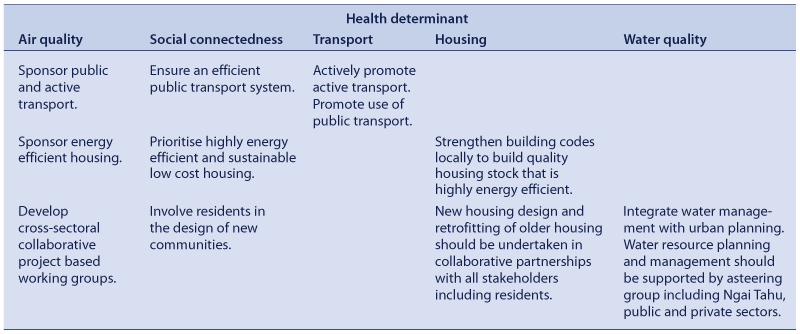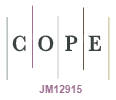Greater Christchurch Draft Urban Development Strategy 2005
Anna Stevenson A C , Karen Banwell B and Ramon Pink AA Canterbury District Health Board, New Zealand
B Christchurch City Council, New Zealand
C Corresponding author. Email: anna.stevenson@cdhb.govt.nz
NSW Public Health Bulletin 18(10) 182-184 https://doi.org/10.1071/NB07077
Published: 26 September 2007
Abstract
The first health impact assessment (HIA) performed on a high level local government policy in New Zealand was undertaken on the Greater Christchurch Urban Development Strategy in 2005. This report describes its development and implementation and the results from the process evaluation including some recommendations made in the assessment. We concluded that HIA is a useful tool for local government policy analysts and we recommend it.
Since it was established in 2001, the New Zealand Public Health Advisory Committee has been promoting the use of health impact assessment (HIA) for local and central government as a way to ensure that health and well-being are considered during the development of public policy. This promotion has included publishing A Guide to Health Impact Assessment: A Policy Tool for New Zealand,1 evaluating the experience of HIA and subsidising the costs of training about 300 people across a range of organisations. The following is a brief summary of our experience of undertaking an HIA on the Greater Christchurch Urban Development Strategy. A full description of this HIA has been published elsewhere.2
In April 2005, the community of Greater Christchurch was asked to choose one of the following four options for how future urban growth might proceed: business as usual with most growth occurring in green-field development; concentration with growth in Christchurch City and a few other larger towns in the district; consolidation with balanced growth within existing areas and some green-field areas; and dispersal which allowed for ongoing urban sprawl. More than two thirds of over 3250 responders chose the concentration option where growth is concentrated in current urban areas. The community was also clear about the need to protect water quality, the environment, heritage and the character of communities as well as to provide more transport options.
How the HIA was conducted
A steering committee with representatives from Christchurch City Council and the Public Health Unit was formed to guide the development of the HIA. A screening and scoping seminar attended by over 30 people from local government, the Public Health Unit, private contractors and academics agreed on the following health determinants to be examined by the HIA:
-
air quality
-
water quality
-
waste management
-
social connectedness
-
housing
-
transport.
A parallel work stream focussed on engaging with Ngai Tahu who are Tangata Whenua, the local Maori tribe. Te Runanga o Ngai Tahu (representative body) works on behalf of the tribe with local government to promote their interests and ensure their aspirations are met. A working group of staff from Christchurch City Council, including a member of the Urban Development Strategy team, and the Public Health Unit worked together to advance the HIA. By the time it was agreed to progress with the HIA, the results from the community consultation were available and it was agreed that the focus should be on comparing the options of business as usual with a concentration option.
Seven workshops were held to obtain key informant perspectives on air and water quality, social connectedness and waste management. Literature reviews were also completed for all determinants. Time constraints meant that the work on housing and transport was limited to the literature review. A separate workshop was held for local Maori and a final review workshop provided comments on the preliminary results to all participants. The recommendations of the HIA were presented to the Urban Forum (the Governance steering group for the Urban Development Strategy) in December 2005 and the final report was published in April 2006.3
Process evaluation
A public health physician conducted an evaluation of the HIA process from the outset of the project. Three main themes emerged from the evaluation. First, there was overwhelming support for the process by all those involved. Second, there was strong support for the intersectoral and multidisciplinary nature of the process. This helped develop a common language between participants and was typified in a quote by one respondent: ‘It was great to see planners sitting there side by side with us health people. I think it helped them understand more about the big picture of public health and that they’re part of it.’ The third theme concerned resourcing, where constraints on time, money and professional capacity (public health staff were diverted to an outbreak of Legionnaires’ disease) limited what could be achieved.
Impact evaluation
A result is that the Urban Development Strategy4 has a dedicated section on health and well-being that would not otherwise have been included. This section acknowledges the importance of the social and environmental determinants of health and urban form to community well-being. The HIA was successful in increasing participation by Maori in governance and implementation of the Strategy. Recommendations were made for each of the health determinants assessed. Of note was the convergence between many of these recommendations (see Table 1).

|
The overarching recommendation that emerged from each workshop was the need for local intersectoral collaboration. The value of working with others from different disciplines across organisations was seen as a great strength of the HIA process. Another result has been the employment of a public health medicine registrar at Christchurch City Council to bring an HIA perspective to the Council’s policy-making process. The Council has committed to incorporating HIA into its standard policy cycle.
A formal evaluation of the impact of the HIA on the Urban Development Strategy is planned.
Discussion
Undertaking an HIA on a policy of this scope and nature was a first in New Zealand. Support for the process was very high from participants and from the Urban Development Strategy Forum members. An informal evaluation on its impact suggests that significant outcomes have been realised, particularly those resulting in changes to the Strategy that we believe are positive for public health.
A significant contribution of this HIA was the support it provided to focus on the drivers for carrying out an urban development strategy. Prior to the HIA the focus was on infrastructure planning, particularly transport and where urban growth could be placed within Greater Christchurch after considering constraints such as flooding, water supply catchment and airport noise contours. The HIA, by concentrating on health and reducing inequalities in health and social outcomes, directed the focus of the Urban Development Strategy more to quality-of-life outcomes. The HIA has also helped to highlight the significance of the statutory and collective responsibilities relating to health and social outcomes within the principal planning legislation.
Finally, the HIA has identified that the Strategy has a role to deliver on health and social outcomes by informing both local and central government about housing, the importance of urban form in supporting walking and cycling and social connectedness, and, of course, to close gaps in health inequalities.
Conclusion and recommendations
This HIA was a pilot process to help assess its utility as a practical tool. Process evaluation of this HIA showed that participants clearly recognised its limitations in terms of resources (budget, staff and time) but were still overwhelmingly positive about their involvement in the process. In retrospect, there were two key outcomes from the process:
-
Participants were able to interact with other agencies face-to-face (working intersectorally became a reality) and helped develop a ‘new language’ that focussed participants on how their roles and decisions influenced health outcomes and
-
The HIA helped put health and social well-being to the forefront of a major policy document on urban planning.
The significance of these developments should not be underestimated. The recognition by different sectors that frequently their goals are the same or similar despite different methods of working and different languages (eg, local government speaks of ‘well-being’ whereas public health practitioners speak of ‘health’) was a revelation for many participants.
Our experience strongly supports the use of HIA in local government policy cycles. We would recommend that other local government bodies consider applying HIA within their decision-making processes.
[1]
[2] Stevenson A, Banwell K, Pink R. Assessing the impacts on health of an urban development strategy: a case study of the Greater Christchurch Urban Development Strategy. Social Policy J NZ 2006; 29 146–64.

[3]
[4]


